Optimized Arrangement of Constant Ambient Air Monitoring Stations in the Kanto Region of Japan
Abstract
:1. Introduction
2. Method
2.1. Air Monitoring Data
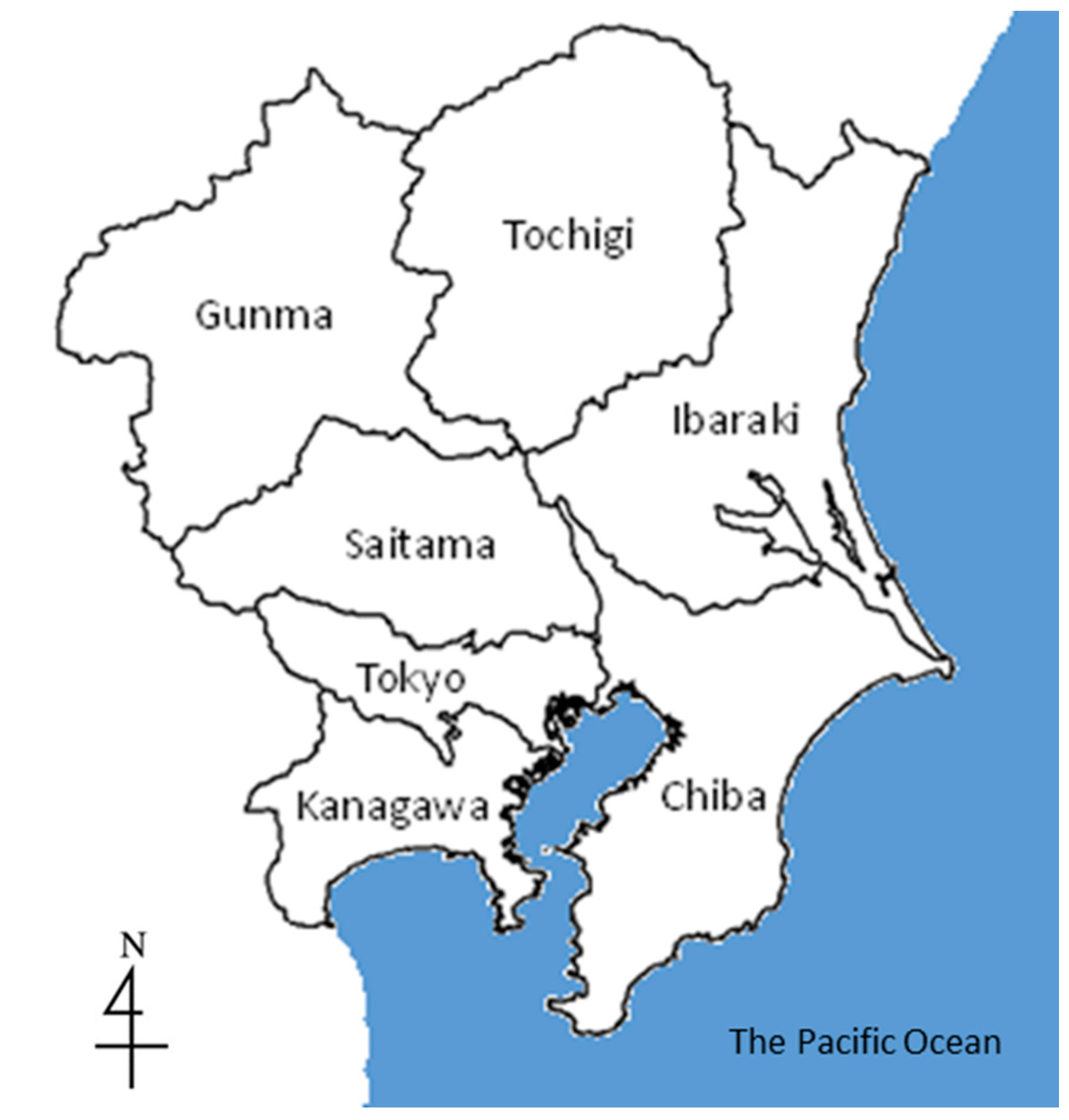
2.2. Grouping of Air Monitoring Stations
2.3. Principal Component Analysis (PCA)
2.4. Characterization of Air Pollution in Each Area
2.5. Reexamination of Constant Air Monitoring Stations
- (1)
- Retain the station if there were similarities between its monitored data and average data of the group to which it belonged;
- (2)
- Retain the station if the monitored data had high concentrations;
- (3)
- Retain the station if the concentration levels had an increasing trend.
3. Results and Discussion
3.1. Grouping by Cluster Analysis and Subsequent Principal Component Analysis
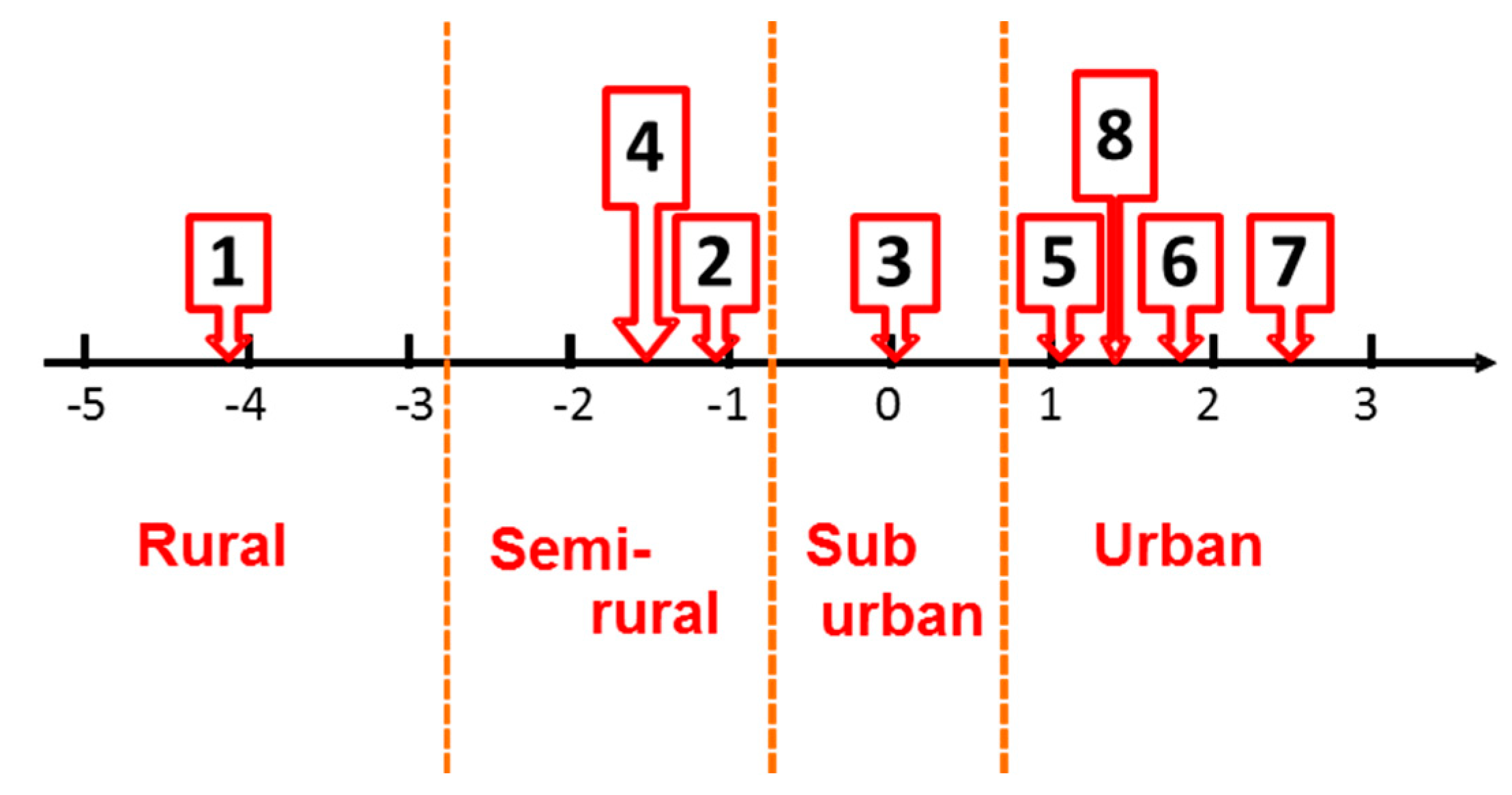
3.2. Air Pollution Characteristics in Each Area
3.2.1. Rural Area
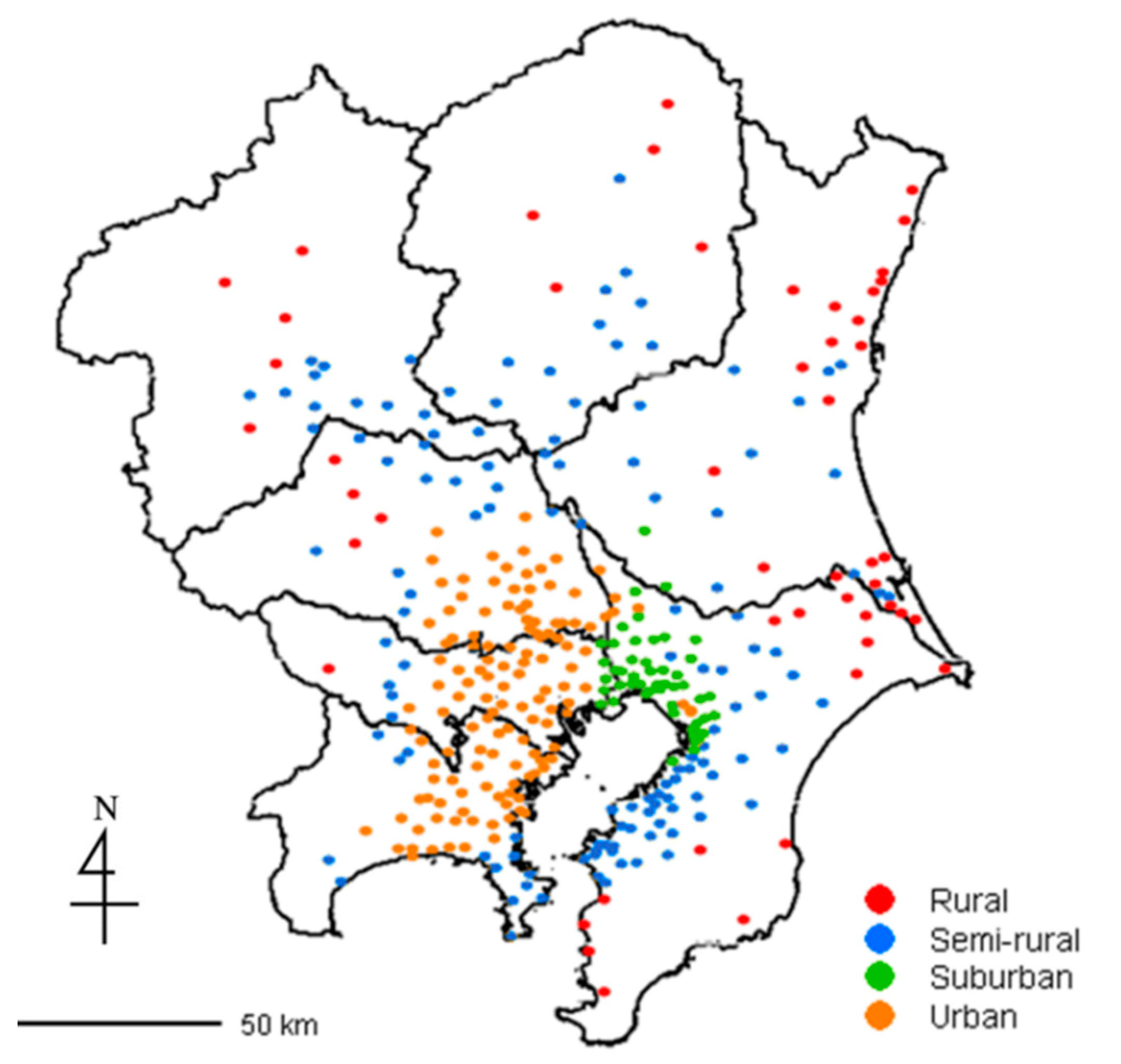
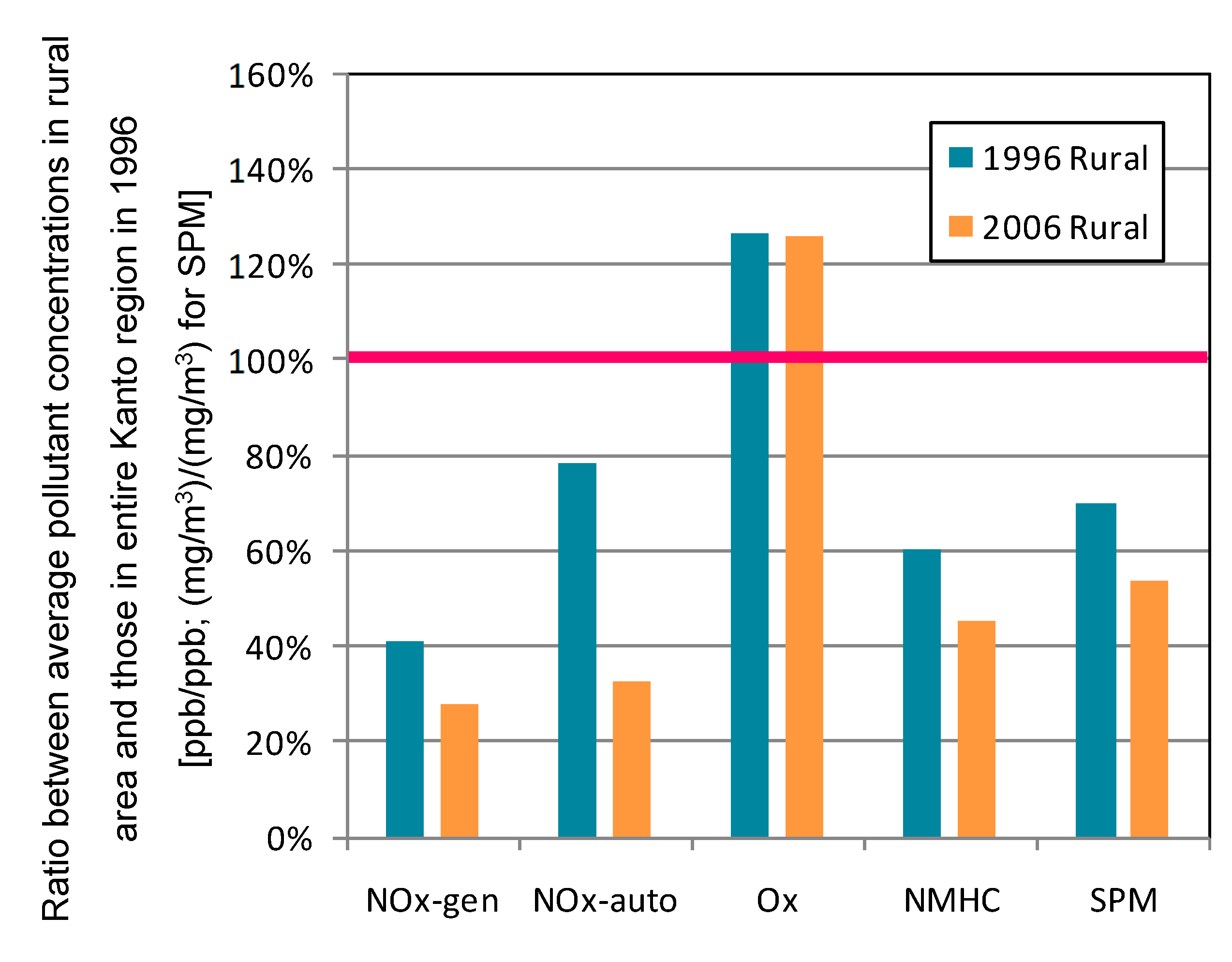
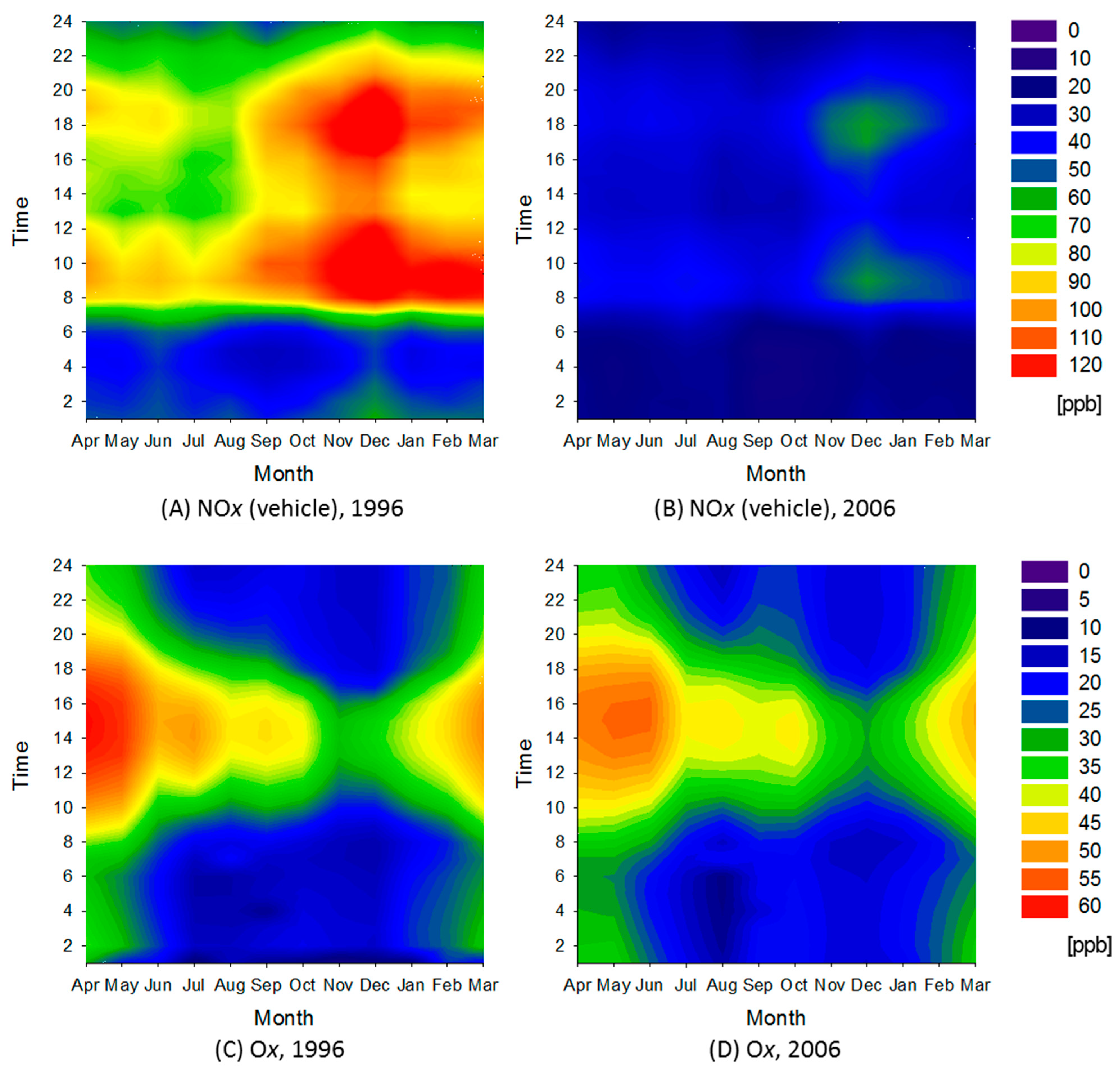
3.2.2. Semi-Rural Area
| Area | Cluster | Average Total Number of Times with Observed Ox Concentrations Greater than 60 ppb | Average Total Number of Times with Observed Ox Concentrations Greater than 120 ppb | ||||
|---|---|---|---|---|---|---|---|
| 1996 | 2006 | 1996 | 2006 | ||||
| Rural | NOx-gen1 | 485 |  | 374 | 7.6 |  | 4.4 |
| Semi-rural | NOx-gen2 | 400 |  | 374 | 7.3 |  | 10 |
| NOx-gen4 | 369 |  | 319 | 4.0 |  | 7.0 | |
| Suburban | NOx-gen3 | 174 |  | 267 | 1.3 |  | 9.5 |
| Urban | NOx-gen5 | 238 |  | 474 | 4.8 |  | 24 |
| NOx-gen6 | 90 |  | 314 | 0.2 |  | 9.6 | |
| NOx-gen7 | 138 |  | 277 | 1.8 |  | 11 | |
| NOx-gen8 | 322 |  | 450 | 2.6 |  | 17 | |
3.2.3. Suburban Area

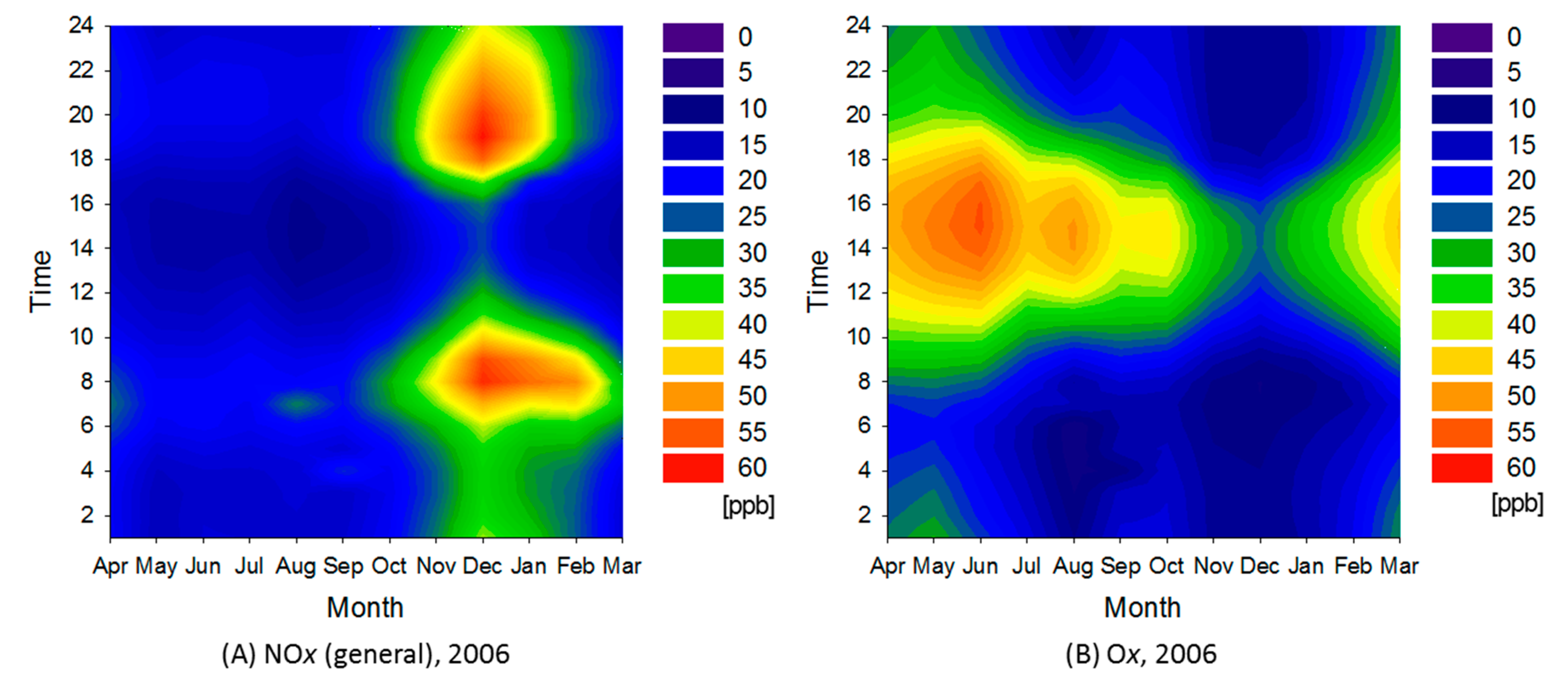

3.2.4. Urban Area

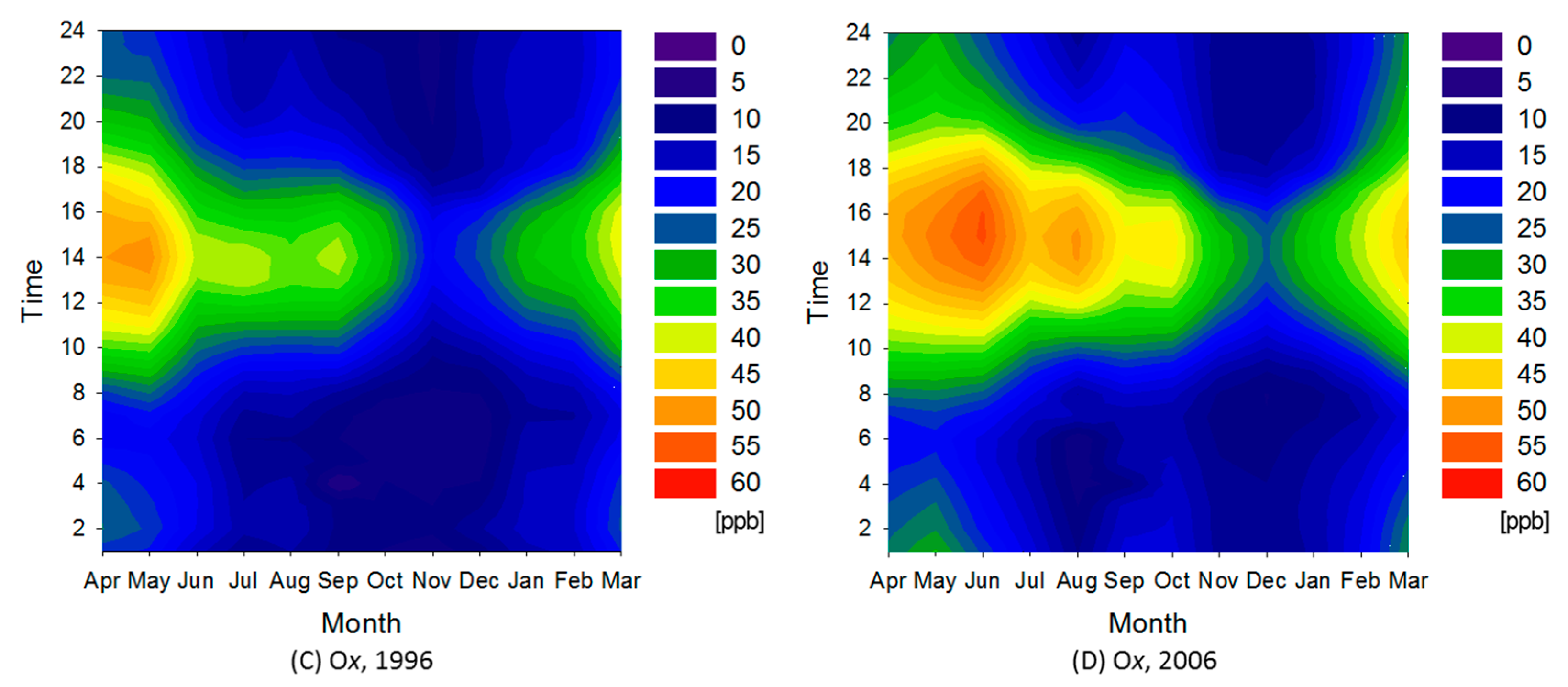
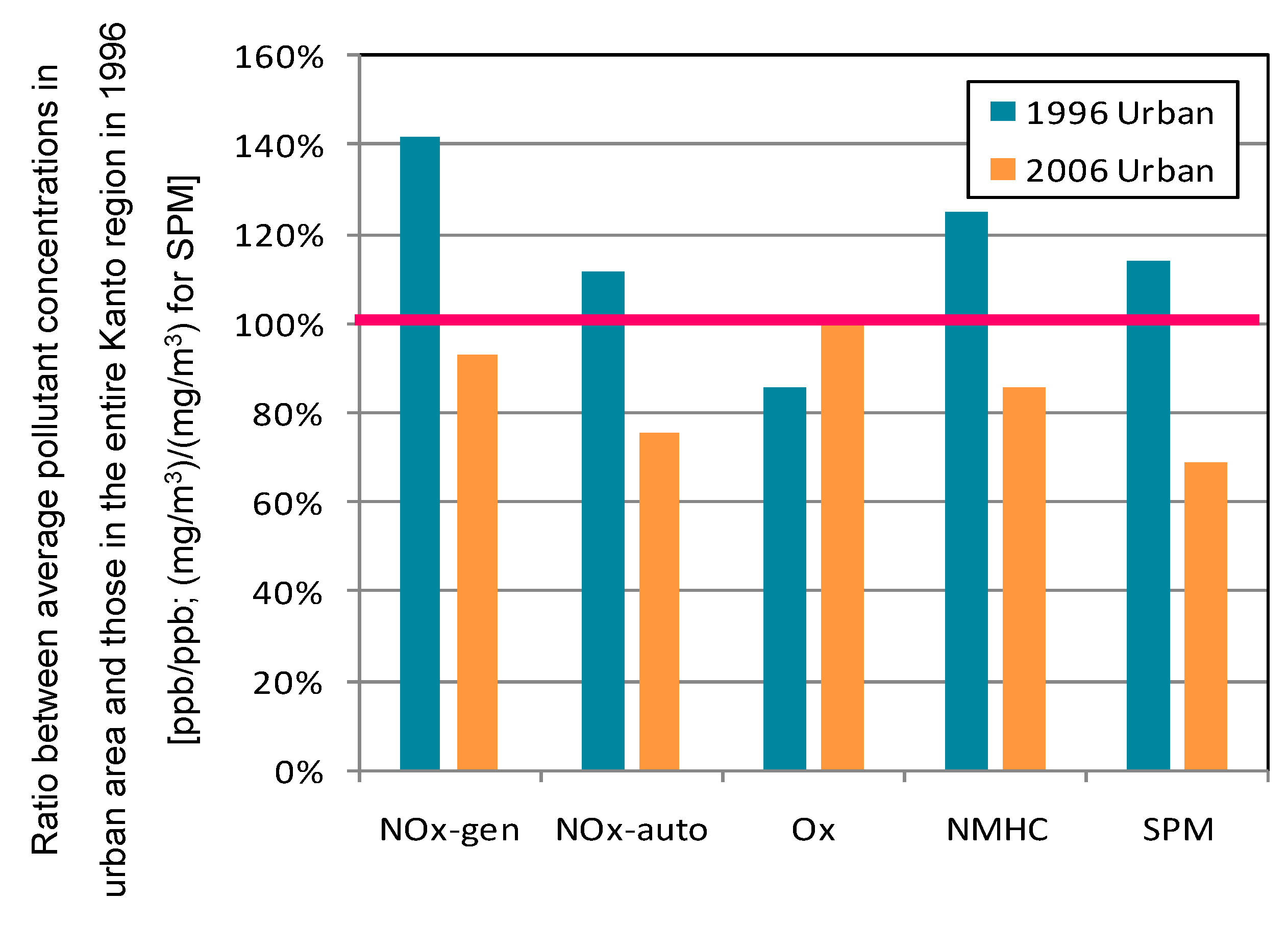
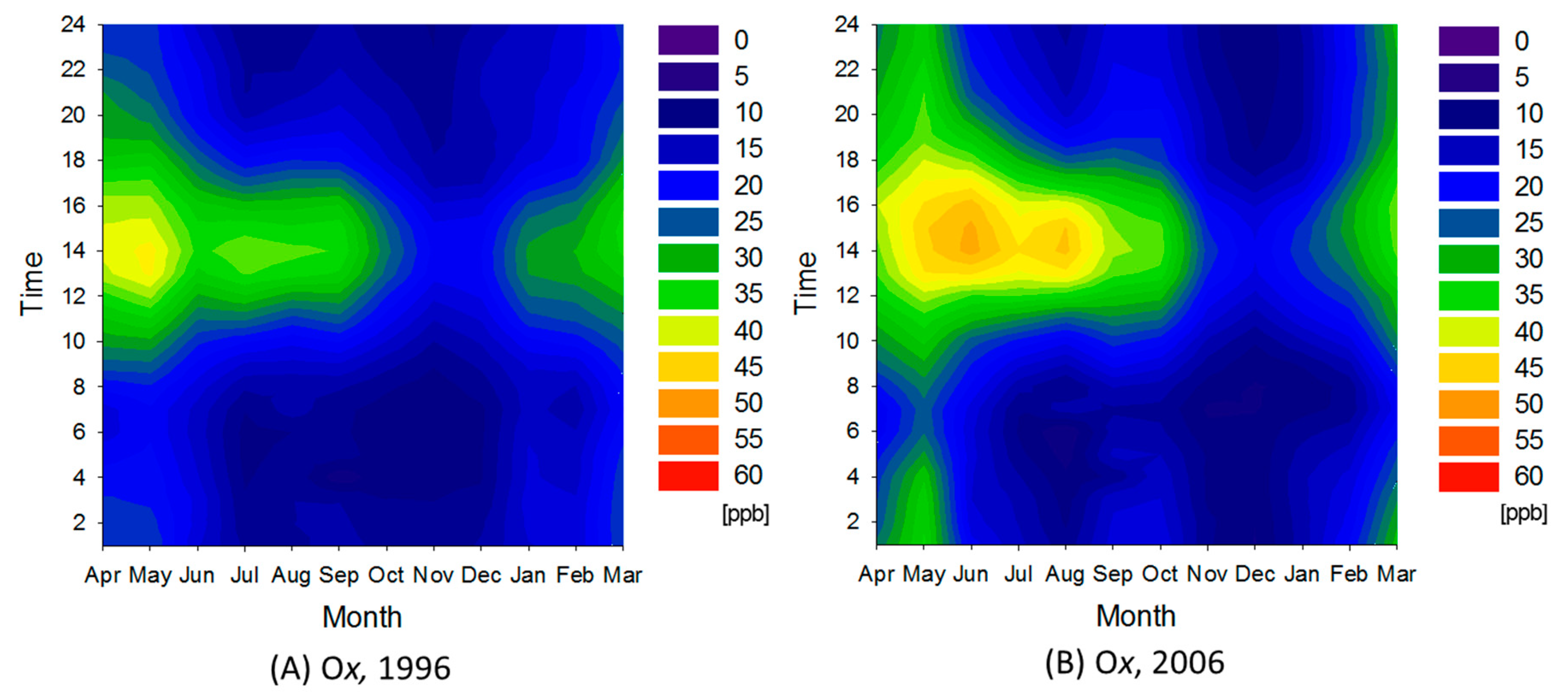
3.2.5. Summary of Air Pollution Characteristics in Each Area
- •
- In the rural area, a smaller ratio of decrease in SPM concentrations was attributable to the smaller contribution of automobiles to pollutant generation.
- •
- In the rural area, average Ox concentration did not decrease; however, the frequency of Ox at higher concentration diminished.
- •
- In the semi-rural area except for Ox, the ratio of decrease in pollutant concentrations was smaller than those in the entire Kanto region. In that area, effects counteracting these pollutants were weak.
- •
- In the suburban area, Ox pollution worsened while NMHC pollution dramatically improved. NOx and SPM pollution also improved.
- •
- In the urban area, SPM pollution was much improved compared with other areas.
- •
- In the urban area, the frequency of Ox concentrations higher than the environmental standard (60 ppb) dramatically increased over the decade.
3.3. Reexamination of Constant Air Monitoring Stations
| Area | Density of Air Monitoring Stations (number/1000 km2) |
|---|---|
| Rural | 3.8 |
| Semi-rural | 12 |
| Suburban | 64 |
| Urban | 56 |
| Station Type and Monitored Pollutant | Before Reexamination | After Reexamination | Ratio of Decrease (%) |
|---|---|---|---|
| Total air monitoring stations | 293 | 186 | 36.5 |
| Vehicle emission monitoring stations | 109 | 65 | 40.4 |
| NOx (general) | 180 | 120 | 33.3 |
| NOx (vehicle) | 109 | 65 | 40.4 |
| Ox | 160 | 111 | 30.6 |
| NMHC | 113 | 79 | 30.1 |
| SPM | 289 | 185 | 36.0 |
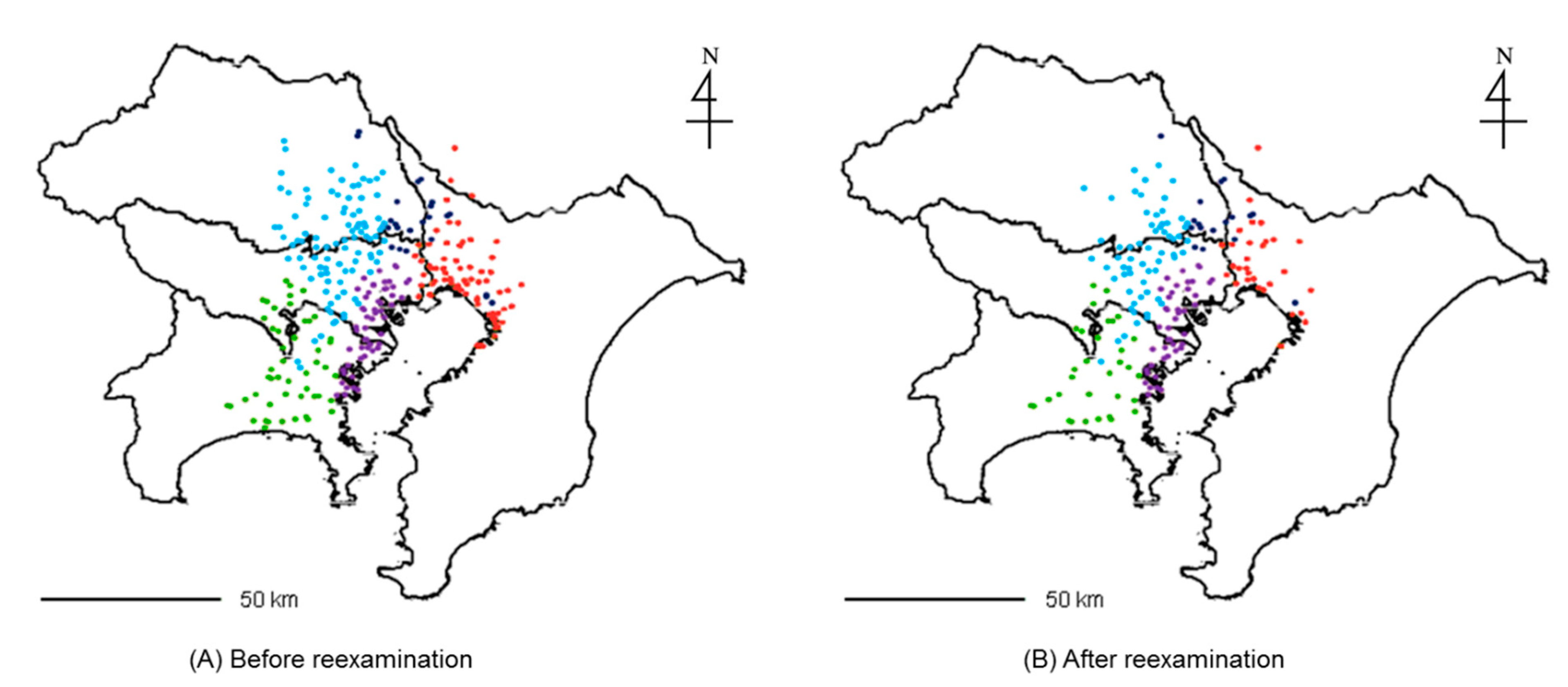
| Monitored Pollutant | Average Concentration (ppb; mg/m3 for SPM) | |
|---|---|---|
| Before Reexamination | After Reexamination | |
| NOx (general) | 34.8 | 32.3 |
| NOx (vehicle) | 69.9 | 61.7 |
| Ox | 23.7 | 23.6 |
| NMHC | 268.5 | 267.3 |
| SPM | 31.1 | 31.0 |
3.4. Recommendations for More Efficient Continuous Air Monitoring System in Kanto Region
| Retention Ratio of the Criteria (%) | Retained | Removed | Ratio of Decrease (%) |
|---|---|---|---|
| 5 | 121 | 172 | 58.7 |
| 10 | 186 | 107 | 36.5 |
| 15 | 233 | 60 | 20.5 |
3.4.1. Mobile Monitoring Stations
3.4.2. Monitoring Stations for Local NMHC Pollution
3.4.3. Ox-Prioritized Monitoring Stations
4. Conclusions
Acknowledgments
Author Contributions
Conflicts of Interest
References
- U.S. EPA. Technology Transfer Network, Ambient Monitoring Technology Information Center. Available online: http://www.epa.gov/ttn/amtic/ (accessed on 10 December 2014).
- DEFRA. Monitoring Networks. Available online: http://uk-air.defra.gov.uk/networks/ (accessed on 8 February 2015).
- UBA. Measuring/Observing/Monitoring. Available online: http://www.umweltbundesamt.de/en/topics/air/measuringobservingmonitoring (accessed on 10 December 2014).
- AIRPARIF. Air Quality Monitoring Network. Available online: http://www.airparif.asso.fr/en/ (accessed on 10 December 2014).
- MOE Government of Japan. Atmospheric Environmental Regional Observation System: AEROS. Available online: http://soramame.taiki.go.jp/Index.php (accessed on 11 December 2014). (In Japanese)
- Li, P.; Xin, J.; Bai, X.; Wang, Y.; Wang, S.; Liu, S.; Feng, X. Observational studies and a statistical early warning of surface ozone pollution in Tangshan, the largest heavy industry city of North China. Int. J. Environ. Res. Public Health 2013, 10, 1048–1061. [Google Scholar] [CrossRef] [PubMed]
- Lu, W.Z.; He, H.D.; Leung, A.Y.T. Assessing air quality in Hong Kong: A proposed, revised air pollution index (API). Build. Environ. 2011, 46, 2562–2569. [Google Scholar] [CrossRef]
- Operating Standards Related to Monitoring of Air Pollution Circumstances Based on the Stipulation of Air Pollution Control Act Article 22 (Revised). 2013. Available online: https://www.env.go.jp/air/osen/law22_kijun/1308303d.pdf (accessed on 2 March 2014). (In Japanese)
- Effective Distribution of Air Pollution Monitoring Stations (Report). 2007. Available online: http://www.city.shizuoka.jp/000063126.pdf (accessed on 2 March 2015). (In Japanese)
- Funabashi shi Environment Council. Report of a Planning Research for Effective Distribution of Air Pollution Monitoring in Funabashi shi; Funabashi shi Environment Council: Funabashi City, Janpan, 2006. (In Japanese) [Google Scholar]
- Hiroshima Prefectural Environmental Citizen Office Environment Division. Report of a Plan for Redevelopment of Network of Air Pollution Monitoring in Hiroshima Prefecture (Summary); Hiroshima Prefectural Environmental Citizen Office Environment Division: Hiroshima City, Janpan, 2008. (In Japanese) [Google Scholar]
- Iizuka, A.; Shirato, S.; Mizukoshi, A.; Noguchi, M.; Yamasaki, A.; Yanagisawa, Y. A cluster analysis of constant ambient air monitoring data from the Kanto Region of Japan. Int. J. Environ Res Public Health 2014, 11, 6844–6855. [Google Scholar] [CrossRef] [PubMed]
- Lau, J.; Hung, W.T.; Cheung, C.S. Interpretation of air quality in relation to monitoring station’s surroundings. Atmos. Environ. 2009, 43, 769–777. [Google Scholar] [CrossRef]
- Dominick, D.; Juahir, H.; Latif, M.T.; Zain, S.M.; Aris, A.Z. Spatial assessment of air quality patterns in Malaysia using multivariate analysis. Atmos. Environ. 2012, 60, 172–181. [Google Scholar] [CrossRef]
- Azid, A.; Juahir, H.; Toriman, M.E.; Kamarudin, M.K.A.; Saudi, A.S.M.; Hasnam, C.N.C.; Aziz, N.A.A.; Azaman, F.; Latif, M.T.; Zainuddin, S.F.M.; et al. Prediction of the level of air pollution using principal component analysis and artificial neural network techniques: A case study in Malaysia. Water Air Soil Pollut. 2014, 225. [Google Scholar] [CrossRef]
- Latif, M.T.; Dominick, D.; Ahamad, F.; Khan, M.F.; Juneng, L.; Hamzah, F.M.; Nadzir, M.S.M. Long term assessment of air quality from a background station on the Malaysian Peninsula. Sci. Total Environ. 2014, 482–483, 336–348. [Google Scholar] [CrossRef] [PubMed]
- Pires, J.C.M.; Sousa, S.I.V.; Pereira, M.C.; Alvim-Ferraz, M.C.M.; Martins, F.G. Management of air quality monitoring using principal component and cluster analysis—Part I: SO2 and PM10. Atmos. Environ. 2008, 42, 1249–1260. [Google Scholar] [CrossRef]
- Pires, J.C.M.; Sousa, S.I.V.; Pereira, M.C.; Alvim-Ferraz, M.C.M.; Martins, F.G. Management of air quality monitoring using principal component and cluster analysis—Part II: CO, NO2 and O3. Atmos. Environ. 2008, 42, 1261–1274. [Google Scholar] [CrossRef]
- Pires, J.C.M.; Pereira, M.C.; Alvim-Ferraz, M.C.M.; Martins, F.G. Identification of redundant air quality measurements through the use of principal component analysis. Atmos. Environ. 2009, 43, 3837–3842. [Google Scholar] [CrossRef]
- Ibarra-Berastegi, G.; Sáenz, J.; Ezcurra, A.; Ganzedo, U.; de Argandoña, J.D.; Errasti, I.; Fernandez-Ferrero, A.; Polanco-Martínez, J. Assessing spatial variability of SO2 field as detected by an air quality network using self-organizing maps, cluster, and principal component analysis. Atmos. Environ. 2009, 43, 3829–3836. [Google Scholar] [CrossRef]
- Lu, W.Z.; He, H.D.; Dong, L.Y. Performance assessment of air quality monitoring networks using principal component analysis and cluster analysis. Build. Environ. 2011, 46, 577–583. [Google Scholar] [CrossRef]
- MOE Government of Japan. Manual for Environmental Air Constant Monitoring, 6th ed.; Environmental Management Bureau: Tokyo, Japan, 2007. (In Japanese) [Google Scholar]
- Tarasova, O.A.; Brenninkmeijer, C.A.M.; Jockel, P.; Zvyagintsev, A.M.; Kuznetsov, G.I. A climatology of surface ozone in the extra tropics: Cluster analysis of observations and model results. Atmos. Chem. Phys. 2007, 7, 6099–6117. [Google Scholar] [CrossRef]
- Zvyagintsev, A.M.; Tarasova, O.A.; Kuznetsov, G.I. Seasonal and daily cycles of surface ozone in the extratropical latitudes. Izv. Atmos. Ocean. Phys. 2008, 44, 474–485. [Google Scholar] [CrossRef]
© 2015 by the authors; licensee MDPI, Basel, Switzerland. This article is an open access article distributed under the terms and conditions of the Creative Commons Attribution license (http://creativecommons.org/licenses/by/4.0/).
Share and Cite
Shirato, S.; Iizuka, A.; Mizukoshi, A.; Noguchi, M.; Yamasaki, A.; Yanagisawa, Y. Optimized Arrangement of Constant Ambient Air Monitoring Stations in the Kanto Region of Japan. Int. J. Environ. Res. Public Health 2015, 12, 2950-2966. https://doi.org/10.3390/ijerph120302950
Shirato S, Iizuka A, Mizukoshi A, Noguchi M, Yamasaki A, Yanagisawa Y. Optimized Arrangement of Constant Ambient Air Monitoring Stations in the Kanto Region of Japan. International Journal of Environmental Research and Public Health. 2015; 12(3):2950-2966. https://doi.org/10.3390/ijerph120302950
Chicago/Turabian StyleShirato, Shintaro, Atsushi Iizuka, Atsushi Mizukoshi, Miyuki Noguchi, Akihiro Yamasaki, and Yukio Yanagisawa. 2015. "Optimized Arrangement of Constant Ambient Air Monitoring Stations in the Kanto Region of Japan" International Journal of Environmental Research and Public Health 12, no. 3: 2950-2966. https://doi.org/10.3390/ijerph120302950
APA StyleShirato, S., Iizuka, A., Mizukoshi, A., Noguchi, M., Yamasaki, A., & Yanagisawa, Y. (2015). Optimized Arrangement of Constant Ambient Air Monitoring Stations in the Kanto Region of Japan. International Journal of Environmental Research and Public Health, 12(3), 2950-2966. https://doi.org/10.3390/ijerph120302950






